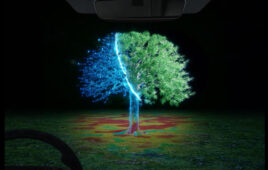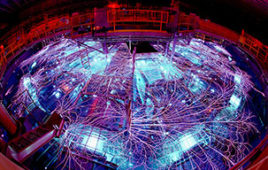
For the first time, holograms could now be made of arbitrary objects, not just photographic transparencies. The appearance of a crystal-clear three-dimensional train completely transfixed the optical community. (Credit: University of Michigan)
Every year, R&D Magazine is privileged to choose groundbreaking innovators for the annual top science award—the Scientist of the Year.
For half a century, this prestigious award has recognized many of the world’s distinguished scientists and most accomplished researchers. Without exception, its recipients have made substantial contributions to their field of study, including material science, physics, biology and chemistry.
As that time of year is once again upon us, R&D Magazine is looking back and profiling its past winners and prominent innovators of our time.
It all had to start with someone, and it did, in 1966, when R&D Magazine chose its very first recipient of the prestigious Scientist of the Year Award—Emmett Leith, Ph.D. The professor of electrical engineering at the University of Michigan was presented with the honor for co-inventing the three-dimensional holography, better known as the technology of laser to help create 3D photography. Holograms are commonplace today and can be found on credits cards and children’s stickers, among other industrial applications. But in Leith’s time when his work, along with coworker Juris Upatnieks’ of the University of Michigan, was presented at a conference of the Optical Society in 1964, it created a big stir and proved a newly-minted epigram by Arthur C. Clarke that “any sufficiently advanced technology is indistinguishable from magic.”
In a magazine interview, Leith had said that people rushed from the presentation room to the suite next door, lining down the hallway to see the “startlingly realistic” image of a toy train.
“Many of them thought it was done by mirrors,” Leith told Michigan Engineer magazine. “A few wanted to know where the train was. I said, ‘It’s back in Ann Arbor.’”
Much of Leith’s holographic work was an outgrowth of his research on synthetic aperture radar (SAR) performed while a member of the Radar Laboratory of the University of Michigan’s Willow Run Laboratory beginning in 1952.
Aside from being named the very first Scientist of the Year by R&D Magazine, Leith has also received the 1960 IEEE Morris N. Liebmann Memorial Award and the Stuart Ballantine Medal in 1969. In 1979, President Jimmy Carter awarded him with the National Medal of Science for his research. He was also presented with the 1985 Frederic Ives Medal by the OSA.
Leith passed away Dec. 23, 2005, at the age of 78, just five weeks after his retirement reception held in his honor.
“Emmett was a remarkably unassuming gentleman, who was known for his quiet ways, sense of humor, cheerfulness, and by the select few who could truly appreciate it, his brilliant mind. His students and colleagues were privileged to have caught a glimpse into aspects of both his personality and intellect,” wrote faculty members on the University of Michigan’s website.
To learn more about the R&D 100 Conference and Awards Dinner where the 2016 Scientist of the Year will be presented, click here.

3D holography today—pressing multimedia and entertainment icons on a virtual background.




